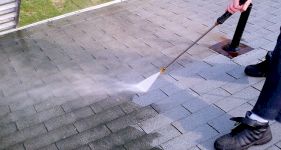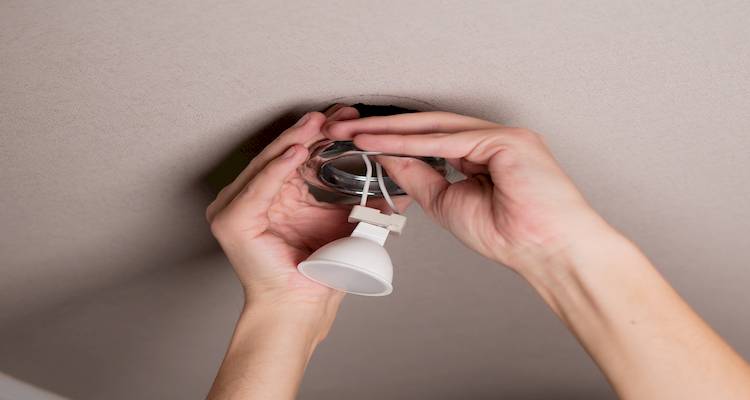How Much Does It Cost to Render a House?
- The average cost to render a house is £5,000 in the UK.
- It typically takes 7 to 10 days for a professional renderer to complete a rendering project.
- NEW! Use our rendering cost calculator for an instant estimate.
- A breakdown of rendering material costs, as well as how much the total rendering price is impacted by the cost of labour.
- How long rendering takes, as well as a general overview of the rendering process.
- How to find and hire a local house renderer using MyJobQuote.
Looking to find out how much rendering costs?
You're in the right place:
In this guide, we cover everything you need to know about house rendering prices.
This includes the rendering cost per m² for different types of rendering material, how much you should expect labour to cost for different-sized houses, FAQs, and more.
Before then, here's a quick look at what you can expect the house rendering cost to be for different-sized houses. This assumes you're using standard materials and paying for a professional to handle the installation.

Want to get an estimate for your house rendering project?
Get free, no-obligation quotes from house renderers near you with MyJobQuote — we take the pain out of getting started with projects like this.
But if you want to learn more?
Scroll down to find our new rendering cost calculator, or keep reading to learn more about rendering house costs.
Let's get started!
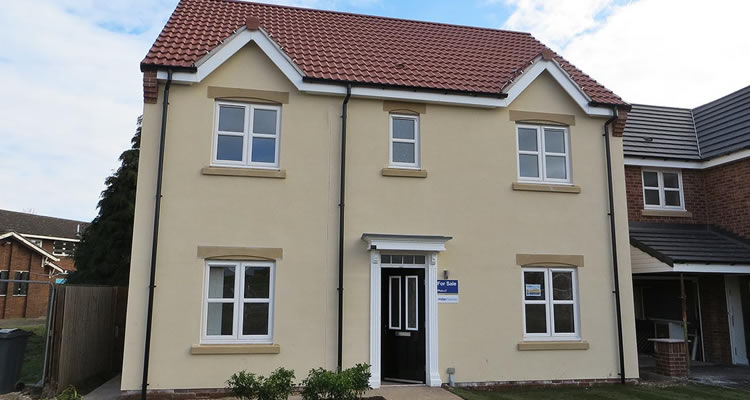
£5,000
Table of Contents
- How Much to Render a House?
- Rendering Material Prices
- Render Removal Costs
- Labour Costs and Timeframes
- Choosing a Brand of Render
- When Can I Paint My Render?
- What Is House Render?
- Why Do You Need House Rendering?
- Pros and Cons of Rendering
- The Process of Rendering a House
- Are My Walls Suitable for Rendering?
- Render Repair Costs
- Render Maintenance and Painting
- Alternatives to House Rendering
- DIY House Rendering
- Insulation Grants
- Planning Permissions and Building Regulations
- Rendering Qualifications to Look Out For
- Hiring a Professional to Render a House
- FAQs
- Sources
How Much to Render a House?
Let's get straight into it:
How much does it cost to render a house in 2025?
House rendering costs range from about £2,000 to upwards of £8,000. This is a wide range, as the cost of house rendering is largely dependent on the size of the property being rendered.
This is highlighted well in the table below.
| Size | Rendering Cost | Duration |
|---|---|---|
| 2 bedroom bungalow | £2,500 - £3,500 | 4 - 6 days |
| 3 bedroom semi-detached house | £4,200 - £5,500 | 6 - 9 days |
| 4 bedroom detached house | £6,700 - £8,300 | 7 - 14 days |
So while the cost to render a 2-bedroom bungalow is between £2,500 - £3,500, the price to render a 4-bedroom detached house would be between £6,700 - £8,300.
But let's take a closer look:
House Rendering Costs
An essential factor that can't be overlooked is the impact that using different type of rendering material has on the total cost of house rendering.
This is highlighted in the tables below.
Bungalow Rendering Cost
| Type of Render | Bungalow (100 m²) |
|---|---|
| Lime | £2,000 |
| Cement | £1,000 |
| Pebbledash | £3,000 |
| Polymer | £3,000 |
| Acrylic | £3,000 |
| Monocouche | £3,500 |
| Paint | £1,000 |
Semi-Detached Rendering Cost
| Type of Render | Semi-detached house (200 m²) |
|---|---|
| Lime | £4,000 |
| Cement | £2,000 |
| Pebbledash | £6,000 |
| Polymer | £6,000 |
| Acrylic | £6,000 |
| Monocouche | £7,000 |
| Paint | £2,000 |
Detached Rendering Cost
| Type of Render | Detached house (300 m²) |
|---|---|
| Lime | £6,000 |
| Cement | £3,000 |
| Pebbledash | £9,000 |
| Polymer | £9,000 |
| Acrylic | £9,000 |
| Monocouche | £10,500 |
| Paint | £3,000 |
Quick Data Summary
What do these tables indicate?
-
Cement render material prices are around £10 per m², which makes them the lowest cost option.
-
Monocouche render material prices are around £35 per m², which makes them the premium option.
These material price differences can make a substantial difference to the affordability of rendering larger houses, with the cost of a monocouche rendered detached house costing more than if you used a cement-based material (around £7,500)
And while it can be tempting to go with the affordable option, there are convincing reasons why you shouldn't automatically rule out more premium render materials.
Let's keep going and dive into that now.
Rendering Cost Calculator
Rendering Material Prices
Lime Render Cost
The lime render cost per m² is around £20.
Lime render is the best option when you're looking for a breathable, flexible, and damp-proof solution. It's also suitable for older properties, as it fits their period aesthetics.
Cement Render Cost
The cement rendering cost per m² is around £10.
Cement rendering is the modern industry standard for external wall rendering.
The affordability of cement render materials is a significant factor in its popularity.
But before selecting this material, it is worth considering that cement render can require multiple coats (increasing the total cost of rendering a home). It also requires painting to maintain a neat appearance.
Pebbledash, Roughcast and Decorative Aggregates
The cost to pebble dash a home per m² starts at around £30.
The finish of the render is a critical consideration.
Pebbledash and roughcast renders are when a coarse medium (small pebbles or gravel) is applied to the base coat. This provides the property with increased resilience to weather and gives a unique texture.
Other types of aggregates, when used in place of pebbles, create an even more unique finish. Modern equivalents even increase the insulation properties of the render itself too.
Which type of exterior render gives you the smoothest finish?
Polymer Render Cost
Polymer render costs per m² starts at around £30.
Polymers are plastics that, when added to a render base, can reduce the risk of cracking in the future.
This also has the added advantage of having the colouring built-in, allowing you to avoid the cost of painting your house after the rendering itself has been completed.
Acrylic Render Cost
The acrylic rendering cost per m² starts at around £30.
Acrylic render is used as a final topcoat over existing render (or new render that you've applied).
Usually, a silicone-based substance is included in the render to reduce the amount of future cleaning required. However, this would substantially increase the cost of acrylic render.
Monocouche Render Cost
Monocouche render cost per m² starts at around £35.
Monocouche render consists of just a single coat.
It's a cement-based render that comes ready to mix with water, which is then usually sprayed onto the property.
It's by far the most expensive rendering choice. However, the increased material costs are offset by the fact that it takes a professional less time to apply and lowers long-term maintenance obligations.
External Paint Costs
The average cost of painting a house exterior with masonry paint per m² is between £10 - £25.
With the multitude of masonry paints available on the market, it's not just the choice of colours that needs to be considered. The decision of finished texture, weatherproof rating, and coats required also involves careful consideration.
All these factors can reduce or increase the final cost of the job.
This means that a small-sized two-bedroom semi-detached house (about 80m²) would require between £800 - £2,000 worth of masonry paint.
Render Removal Costs
Already have existing render on your exterior walls?
In this case, you'll need to hire a rendering company to remove it before you can have it rendered again.
To illustrate what you should expect:
The average pebbledash removal cost is around £4,950.
A large component of this cost is the labour cost a rendering specialist charges for each day. Most specialists charge between £150 - £400 per day for their labour when removing house render, as it's a labour-intensive task. It also worth noting that costs are higher than the national average in areas such as London and the South East.
However, the cost of render removal will also depend on:
The type of rendering being removed
The current condition of the rendering.
The size of your property
The location of your property
If there aren't any delays, then you can expect it to take between 2 - 4 days on average to have the existing house rendering removed.
Render removal may also uncover damage underneath, which needs to be dealt with before the external wall is rendered again. This can mean the job takes longer, and the total cost to remove the render will be higher.
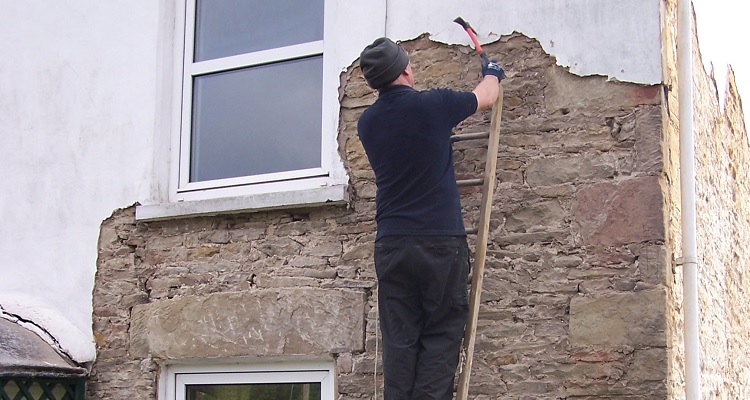
Most rendering contractors will include the cost of render removal in their quotes - but you should always confirm what's included and excluded before proceeding with a project.
But keep in mind that paying for skip hire yourself may be cheaper to arrange yourself than paying a tradesmen to collect.
You may also have to separately consider the cost of hiring scaffolding if required to reach the whole area.
Labour Costs and Timeframes
Labour costs are usually one of the most important factors to consider when planning home renovations.
You should expect to pay around £130 to £250 per day for a rendering specialist, with fees increasing in areas such as London and the South East due to the higher cost of living.
The average house rendering job will run between 7 to 10 days, although larger properties will take longer. However, time frames will vary based on other factors like the render type you've chosen to go with and the weather conditions during the process. For example, more complex rendering will take longer and wet weather may delay proceedings.
When employing a qualified tradesperson, you'll also benefit from a discount on materials - depending on the job size. This can drastically reduce the overall cost of the project and offset part, if not most, of the cost of the labour itself.
For example: For the cost of around £3,000, you could hire an experienced tradesperson to render a 200m² semi-detached property with a basic cement render. However, if done yourself, it could cost up to £3,000 for the materials alone.
The timescale of the work and the processing time of each type of rendering should also be considered. On a hot day, some modern acrylic renders might dry rapidly - once applied, it might only take a few hours for them to be touch-dry.
Conversely, some renders can take multiple days to dry. The majority of renders also require dry conditions to apply.
This is all important to consider when planning a house rendering job.
Choosing a Brand of Render
There are several brands of render considered high-quality that are favoured by many rendering specialists.
Each manufactures a variety of render types, and prices vary depending on the type and finish you want.
Let's take a closer look at this:
K Rend Render Cost
K Rend is the UK’s largest independent coloured silicone render manufacturer.
They offer two products: silicone thin coat and silicone scraped texture.
Both are available in a variety of colours and save you the job of painting any render after it has been applied.
K Rend is known to last longer than traditional sand and cement render. This is because it doesn’t crack, stays clean, is waterproof, and requires no maintenance.
It is more expensive than traditional render, but the benefits seem to outweigh the drawbacks.
The cost of silicone render per m² is between £30 - £70.
Parex Render Cost
In the world of construction, Parex is a well-known brand name.
They produce render, but also do construction repairs, hard landscaping, highway maintenance and are the UK leader in construction chemicals.
Parex offers a range of different renders. This includes monocouche, silicone and acrylic renders that are used in buildings, but also in large infrastructure - such as bridges, roads and railways.
You can expect to cost of Parex render by m² to be between £20-£60.
Weber Render Cost
Weber offers a variety of products, including tile adhesive, grout, concrete repair, structural strengthening, and of course, render!
Weber has an assortment of renders available - from traditional products to more modern styles. One specific product of note is their one-coat pebbledash render that can save a significant amount of time and money.
The cost of Weber rendering products range between £25 - £65.
When Can I Paint My Render?
Once your wall has been rendered, you may want to paint it.
The time until it's ready to paint depends on the weather and the type of render you've used.
The table below approximates when your render will be ready to paint.
| Type of Render | Cold Weather - Below 7ºC - 16ºC | Warm Weather - 17ºC - 25ºC | Will it dry in wet weather? |
|---|---|---|---|
| Lime | 4 - 7 days | 2 - 4 days | No |
| Cement | 5 - 8 days | 2 - 5 days | No |
| Pebbledash | 5 - 9 days | 3 - 6 days | No |
| Polymer | 3 - 5 days | 1 - 3 days | Render Dependent |
| Acrylic | 3 - 5 days | 1 - 4 days | Render Dependent |
| Monocouche | 5 - 10 days | 4 - 6 days | No |
What Is House Render?
House render is an external wall covering that protects the exterior exposed walls of a house from rain and cold weather. It's normally applied by a plasterer or rendering professional.
Traditional renders are often finished with a breathable top coat of paint, which helps reduce surface cracking and adds colour. However, many modern renders (such as silicone or monocouche) are produced with a crack-resistant formula and come readily available in a range of colours.
The exterior of a home is subject to a large degree of weathering and erosion. If it's not protected with some manner, then problems are likely to arise over time.
A layer of cement, lime, or modern resin-based render is applied to a house to negate the amount of weather damage and erosion it experiences.
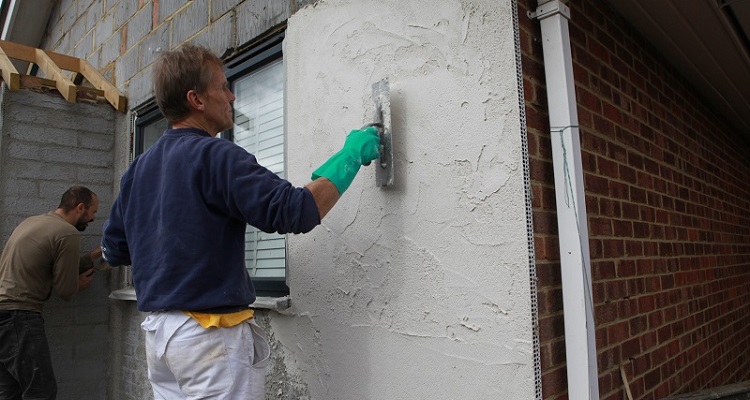
This should lead to lower maintenance costs of your building's exterior. The amount of protection depends heavily on the choice of render materials, the quality of the work carried out, and the local weather.
So how does rendering work?
Render consists of cement, lime, or resin-based powders or liquids. When mixed with water or other chemicals, they form a paste-like substance.
The paste is then smoothed over the walls, using hand tools such as a plasterer’s trowel, to create a barrier layer impervious to water.
Unlike traditional cement and lime based renders, modern resin render often comes in liquid rather than powder form (i.e. it's premixed and ready to apply).
Why Do You Need House Rendering?
External rendering is applied to increase the weather resistance of a property, which helps to reduce the cost (and difficulty) of maintenance which is required.
The outer layer of a house, if built of brick, is actually quite porous. Without a render or glaze layer, it will end up absorbing moisture from the air - resulting in damp penetrating the building with ease.
Render is the best solution to minimise the amount of moisture that is absorbed by the brickwork.
Some types of modern renders also have various additives within the formulations that improve a property's insulation. This not only saves money (lower heating costs), but lowers the environmental impact of your home (less fuel consumption).
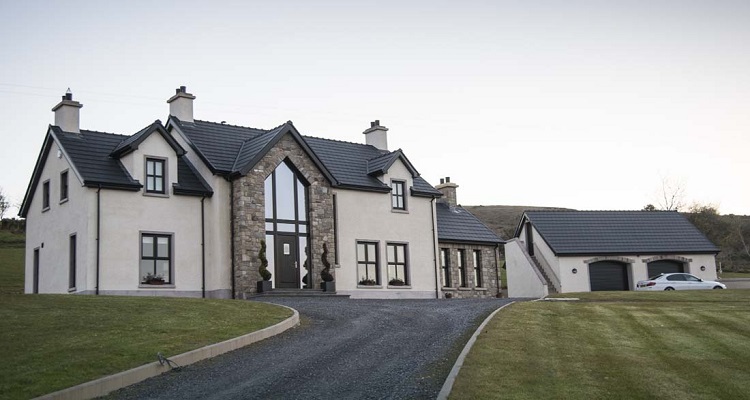
Damp and mould are a big concern when owning a home.
Not only can they be unsightly and off-putting to look at, but they also a substantial health hazard.
Once damp and mould have infected a property, it can be an expensive nightmare to resolve. Because of this, taking preventative steps will be a more affordable long-term choice.
Render provides a protective barrier against moisture and mould. However, the effectiveness will depend on the type and quality of render used, for example, modern breathable lime or modern silicone-based options allow any moisture to escape and therefore help prevent damp.
If you have issues with rising damp, then consider damp proofing your home. The cost of treating rising damp within your home starts at around £30 per m².
Pros and Cons of Rendering
There are both pros and cons of rendering your property.
Let's go through those now.
Pros
There are a variety of rendering materials available, so you'll be able to find something even if you're on a tighter budget.
You can choose from a countless number of rendering paint colours, which gives you more control over the aesthetic of your property.
It allows you to cover mismatched brickwork, cracks, stains, and all manner of unsightly marks that might be making your home stand out for the wrong reasons.
House rendering provides a direct defence against moisture, dampness, and mould.
It can increase your property's market value, but also may increase the insulation rating of your property.
Some of the more expensive, higher-quality rendering materials may offer more protection against vandals (e.g., graffiti).
Cons
Render requires regular maintenance to avoid possible weathering issues, such as cracking and peeling of the paint's topcoat.
The rendering cost can be a substantial outlay for a homeowner, and the return on this investment in the property can be low.
Your property may require planning permission to install wall rendering, and the style or colours you can use may be limited.
If your property has air vents, alarm boxes, or external features, these may need extending - which increases the costs of rendering your home.
The Process of Rendering a House
Rendering your home can be straightforward if there are no unexpected surprises along the way.
Whether you try the DIY option or hire a qualified tradesman, it is important to understand the entire process.
Let's take a look at it.
- Wall Preparation
- External Feature Preparation
- Insulation Options
- Render Foundation
- Render Layers
- The Finish
- Final Touches
It is extremely important for a building to have its exterior walls prepared before any rendering is applied. This includes having the structural stability assessed and any repairs made to the brickwork.
Features such as alarm boxes, drainpipes, and weather flashings will need to be removed. This includes around every door and window frame.
You can apply a base external wall insulation layer before your chosen render. This usually takes the form of sheets or block cladding.
As with most building jobs, a good foundation is vital to the final product. A render mesh (usually a type of special fabric) is used by embedding it into the first layer of render applied.
The layers of render can vary depending on the materials chosen and the desired result. Some may include polymer cement, silicone or acrylic.
If your render has a modern resin base, it often comes pre-coloured. If you are not using pre-coloured render, you may also decide whether you desire a smooth or textured finish.
Once the render has cured and the paint has dried, you'll need to reattach the drainpipes and external features you removed from your walls.
Are My Walls Suitable for Rendering?
There's a critical question you need to ask before planning any house rendering work:
Are the exterior walls of your house capable of being rendered?
To answer, you'll need to look at the walls themselves. Are the walls damaged or eroded? Do the walls have a render coat already? Are the walls of your home already glazed or painted? What is the structural condition of the walls?
The best way to get the questions answered is to hire a surveyor or ask a tradesperson that is quoting for the job.
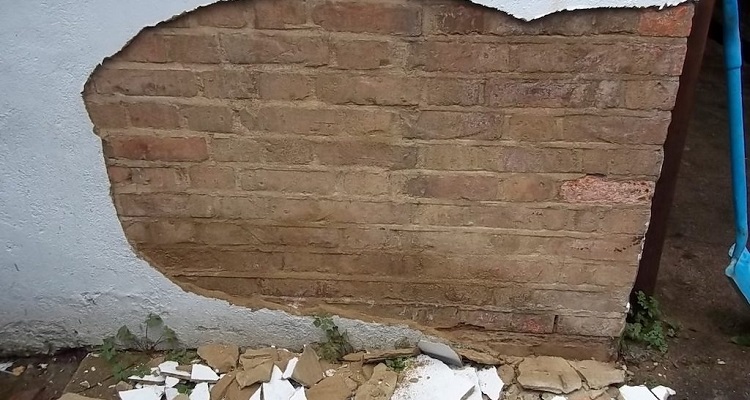
If however, you plan to do the job yourself, then consider these points:
-
Begin with checking for erosion and weather cracks. Should any be evident, you will have to fix them before applying any form of render to the exterior walls.
-
Just because a wall has already been rendered does not mean it cannot be re-rendered. If a wall already has an old coat of render, it can have the old render material removed, be cleaned, and then new materials applied.
-
If there's paint on walls (depending on its quality, age, and type), it can often be cleaned before new render is purchased and applied.
One of the main considerations when deciding if the render will result in a good-quality finish is the structural condition of the walls.
As render is usually a hard, inflexible layer, it requires structurally stable walls. Any movement within the wall once the render has been applied will result in a cracked and poor finish.
Because of this, it's always advisable to have a qualified professional survey the stability of the walls before you invest any money in rendering your house. This is less likely to be needed in newer homes - but in older builds, it becomes increasingly necessary as the property ages.
The average cost of a house survey in the UK is £500.
Render Repair Costs
Render, like almost everything, is subject to damage from time to time.
If you find your old render is not in such poor condition that it requires a complete re-do, yet there is still some damage visible, then maybe a repair job could be your first port of call.
Isolated cracks, missing chunks, and discolourations are all examples of types of render damage which can be easily and cheaply fixed.
Missing chunks can usually be patched with the same type of render as the original.
For a tradesman to do this, the cost of render repair would be around £15 per m² for basic cement render. The price increases to between £25 - £30 per m² for rendering repairs that use modern acrylic and polymer renders.
When applied by a professional, any repairs to rendering can blend in nicely, especially if you're using a smooth finish. A high-quality repair and matching materials make a big difference. Repainting the entire wall can help create a seamless finish, although this is likely to increase the overall cost.
| Type of Render | Patch Repair of 5 m² | Patch Repair of 10 m² |
|---|---|---|
| Lime | £200 | £400 |
| Cement | £100 | £200 |
| Pebbledash | £300 | £600 |
| Polymer | £300 | £600 |
| Acrylic | £300 | £600 |
| Monocouche | £350 | £700 |
This could be a place to try some DIY route - if you are so inclined. However, depending on the size and location of the patch, it might work out simpler and cheaper to hire a professional.
Discolouration can be the simplest fix, costing around £20 per m², and usually involves cleaning the render and reapplying a coat of paint to match the other non-discoloured areas.
When hiring a tradesperson to repair rendering, it's always best to search for one with a good level of experience in repair work (ideally someone who specialises in rendering repair work).
The price of rendering repair work is significantly more affordable than completing re-rendering a property. Because of this, it's always worth dealing with problems as they arise.
Render Maintenance and Painting
Not all types of render require the same levels of maintenance.
Most, if not all, renders will occasionally require a fresh coat of paint. This can sometimes be almost as difficult as the original paint job.
Fortunately, refreshing the paint is only required every 5 - 10 years.
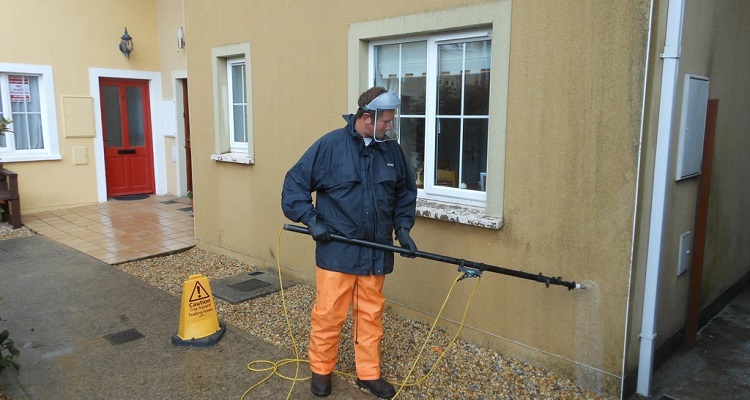
A good way to increase the endurance of your top layer finish (paint or coloured render) is to have it cleaned once a year.
You can do this yourself, but it'll undoubtedly be quicker and easier to hire someone to do it for you.
There are many devices and equipment designed to clean the exterior of your home, from “magic brushes”, which are just brooms with various hose attachments, to various types of soaps designed to remove built-up grease and grime.
If kept clean, render can last an extremely long time before it needs any form of renewal.
That said, house rendering does not last forever.
Even modern forms of rendering, such as acrylic and polymer, will eventually require the topcoat to be reapplied. This type of project might be the same price as you originally paid to have the house rendered.
Because of this, it's worthwhile to invest in regular maintenance so that the house rendering lasts as long as possible.
Alternatives to House Rendering
The two main alternatives to house rendering are:
Painting the external walls of your house.
Installing a cladding system.
The cost of painting a house per m² is between £10 - £15.
Painting your home without proper base protection will not afford the same levels of weather protection as a full house render.
The cost of cladding a house per m² is between £20 - £50.
Simple plastic or acrylic cladding systems tend to be on the lower end of this range (about £20 per m²). A high-quality wood or metal cladding system will be on the higher end (about £50 per m²).
While these alternatives might be cheaper than house rendering costs, they have different pros and cons that you should consider.
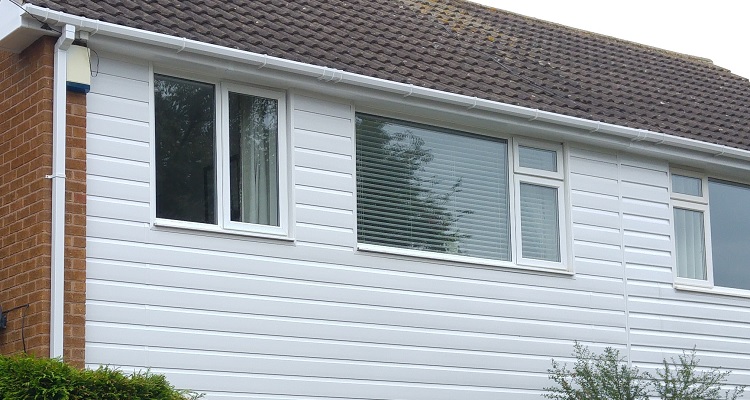
DIY House Rendering
Thinking about doing your own house rendering work?
The most important factor to consider is the difficulty of rendering a house and assessing how much you'll actually be saving on the total cost of rendering.
Let's look at the main points:
-
Rendering a home is a significant project to take on yourself. You'll need to conduct the surveying, map the scope of the project out, prepare the rendering materials and your external walls, apply the rendering correctly, finish the render, and then correctly keep it maintained. This is far beyond what the average DIY enthusiast is capable of.
-
It might not save you as much money as you expect. Most tradespeople who regular purchase the same type of materials from a supplier will get better rendering material prices than you would as a one-off customer.
-
Consider the value of your time. The time estimates we provide in this cost guide are based on professionals completing the job. As someone without previous experience, it will likely take you significantly longer - and that's assuming you don't make mistakes along the way.
It's usually better to hire a reputable and qualified tradesperson to complete the a house rendering project.
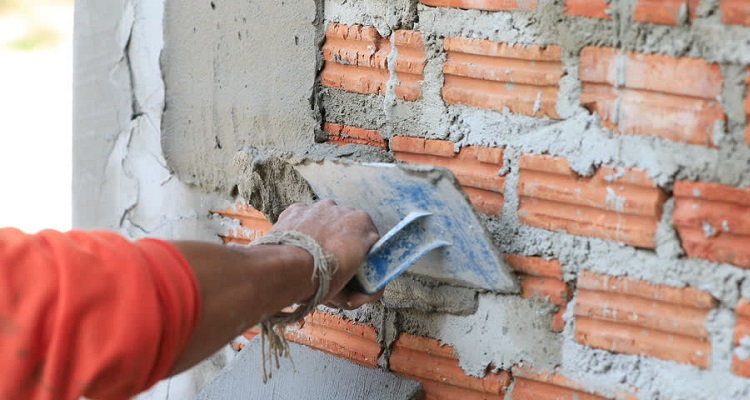
But if you're determined to render your home independently, you may want to consider practicing first. Rendering garden walls or another external wall that's isolated and lower-risk would be a great place to give it a go.
Insulation Grants
There are sometimes grants available from the government to assist in insulating properties.
These are part of the Energy Company Obligation (ECO), a governmental scheme set up to help low-income, fixed-budget households increase the insulation in their homes. This specific grant is funded by utility companies and is available to houses in England, Wales, and Scotland.
Not every person will qualify for this grant scheme.
If you do qualify, it might cover a portion (or all) of the cost of re-insulating a property. This can make a substantial difference to the total cost, so it's worth taking the time to check whether you meet the criteria.
To check whether you are eligible for the grant, it's best to check your local authority's website or contact them - as rules can vary depending on your location in the UK.
If you qualify for one of these grants, you'll need to hire a registered installer to perform the work.
Planning Permissions and Building Regulations
In the majority of cases, planning permission isn't required when rendering a house, as it is considered a permitted development due to coming under routine maintenance or cosmetic improvements.
As such, you can usually apply new render to existing walls without needing approval from the local council. However, if your home is in a conservation area or a listed building, you may need permission before rendering.
Likewise, in the event any planned work will significantly change the appearance of your property or is part of a larger renovation, it’s best to check with your local planning authority first.
When rendering a house, you must follow Building Regulations to ensure the work meets safety and energy efficiency standards. If your proposed rendering covers more than 25% of the wall, you may need to upgrade the structure of the wall to ensure it meets current thermal requirements.
If in doubt, it’s important to check with your local Building Control before starting, especially for older or listed buildings that may also have additional requirements.
Rendering Qualifications to Look Out For
In the building trade, different jobs are covered by specialist qualifications.
This is important to look out for when receiving quotes from tradespeople.
Here are some things to keep in mind:
The best place to start is to ask where they trained, what courses they have completed, and what they've specialised in doing.
One qualification to look out for is the City and Guilds award. These have different levels, with higher numbers meaning that the tradesperson has received more qualifications.
When it comes to house rendering, plasterers are usually the first type of tradesperson to start with. However, not all interior plasterers perform exterior work.
Reviews from previous customers should not be overlooked. A tradesperson who received bad reviews or has a bad reputation should be avoided - no matter how much money they claim they could save you.
Another important factor to consider before hiring a tradesperson to render your home is whether they are fully insured to do the work.
Insurance is your safety net if the project goes wrong in some way.
This is what saves you from having to shell out costly amounts from your pocket to fix mistakes that a tradesperson might make - which you had no hand in creating.
Tradespeople without adequate liability insurance to cover the potential damage that could be caused by their activities should not be hired to undertake any work on your property - even if they're offering an attractive house rendering price.
Hiring a Professional to Render a House
Once you've decided to hire a professional to render your property, the next step is to find the right tradesperson for the job:
-
Local tradespeople are always the best place to start. Using MyJobQuote, you can easily get quotes from 3 local renderers near you.
-
Look out for City and Guild qualifications. The tradesperson may also have other qualifications and/or awards which demonstrate their abilities.
-
Check their previous house rendering work and feedback they've received. On MyJobQuote, you can find reviews from homeowners who've used them for jobs before on the tradesperson's profile page. You'll also find pictures of their previous projects on this page.
-
Ask for proof of their liability insurance. This proves that they're insured for any damage they cause to your property.
-
Ensure you have a written agreement for the rendering work. This will provide you and the tradesperson with a clear outline of the job's scope and what costs are included or excluded.
-
Get a written receipt when making any payments. This will protect you from any potential disputes about payment in the future.
FAQs
What is pebble-dash and roughcast?
They are both forms of render that involve adding pebbles or pieces of stone for extra texture. The difference between them is largely in the application - pebble-dash tends to be more durable and involves pressing stones onto wet render, while roughcast mixes them in beforehand.
Are plastering and rendering the same thing?
Although both follow a similar process in principle, the materials used are significantly different. Plastering is also generally associated with internal work, whereas rendering is largely for external walls.
How do you prepare the surfaces for rendering?
To prepare a surface for rendering, the wall must be thoroughly cleaned to remove loose paint, dust, debris in general and mould which should be treated with bleach or fungicide. After washing, the wall should be allowed to start to dry. Preparing the surface may already be included within any quotes you receive, although it's best to check first.
My walls are painted. Can I just repaint them and not have to re-render them?
If the rendering underneath the house paint shows no signs of damage, you can simply have a professional clean and repaint the surface.
I like the exposed brickwork aesthetic. Is there any way to render my property and keep the look?
Once a wall has been rendered, you won't visually be able to see the brickwork underneath it. However, glazes are available on the UK market that provide the benefits of rendering (e.g., weather protection) without covering up the brickwork that some people prefer.
Should I use a lime-based render?
Lime-based render is ideal for older buildings as it’s breathable and more flexible than cement render. Though more expensive, it can reduce future issues. If unsure, get advice from experienced renderers to choose the right material for your property.
You can easily get quotes from local external renderers with MyJobQuote.
Is house rendering worth it?
Rendering offers benefits that include improved insulation, weather protection and can reduced maintenance. While it may not always boost the value of your property, it's certainly beneficial for long-term homeowners wishing to protect and enhance their home's exterior.
Sources
https://forums.moneysavingexpert.com/showthread.php?t=5199873
https://www.self-build.co.uk/how-get-render-right/






